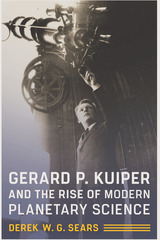2 books about 1905-1973

Gerard P. Kuiper and the Rise of Modern Planetary Science
Derek W. G. Sears
University of Arizona Press, 2019
Astronomer Gerard P. Kuiper ignored the traditional boundaries of his subject. Using telescopes and the laboratory, he made the solar system a familiar, intriguing place. “It is not astronomy,” complained his colleagues, and they were right. Kuiper had created a new discipline we now call planetary science.
Kuiper was an acclaimed astronomer of binary stars and white dwarfs when he accidentally discovered that Titan, the massive moon of Saturn, had an atmosphere. This turned our understanding of planetary atmospheres on its head, and it set Kuiper on a path of staggering discoveries: Pluto was not a planet, planets around other stars were common, some asteroids were primary while some were just fragments of bigger asteroids, some moons were primary and some were captured asteroids or comets, the atmosphere of Mars was carbon dioxide, and there were two new moons in the sky, one orbiting Uranus and one orbiting Neptune.
He produced a monumental photographic atlas of the Moon at a time when men were landing on our nearest neighbor, and he played an important part in that effort. He also created some of the world’s major observatories in Hawai‘i and Chile. However, most remarkable was that the keys to his success sprang from his wartime activities, which led him to new techniques. This would change everything.
Sears shows a brilliant but at times unpopular man who attracted as much dislike as acclaim. This in-depth history includes some of the twentieth century’s most intriguing scientists, from Harold Urey to Carl Sagan, who worked with—and sometimes against—the father of modern planetary science. Now, as NASA and other space agencies explore the solar system, they take with them many of the ideas and concepts first described by Gerard P. Kuiper.
Kuiper was an acclaimed astronomer of binary stars and white dwarfs when he accidentally discovered that Titan, the massive moon of Saturn, had an atmosphere. This turned our understanding of planetary atmospheres on its head, and it set Kuiper on a path of staggering discoveries: Pluto was not a planet, planets around other stars were common, some asteroids were primary while some were just fragments of bigger asteroids, some moons were primary and some were captured asteroids or comets, the atmosphere of Mars was carbon dioxide, and there were two new moons in the sky, one orbiting Uranus and one orbiting Neptune.
He produced a monumental photographic atlas of the Moon at a time when men were landing on our nearest neighbor, and he played an important part in that effort. He also created some of the world’s major observatories in Hawai‘i and Chile. However, most remarkable was that the keys to his success sprang from his wartime activities, which led him to new techniques. This would change everything.
Sears shows a brilliant but at times unpopular man who attracted as much dislike as acclaim. This in-depth history includes some of the twentieth century’s most intriguing scientists, from Harold Urey to Carl Sagan, who worked with—and sometimes against—the father of modern planetary science. Now, as NASA and other space agencies explore the solar system, they take with them many of the ideas and concepts first described by Gerard P. Kuiper.
[more]

The Priest Who Put Europe Back Together
The Life of Rev. Fabian Flynn, CP
Sean Brennan
Catholic University of America Press, 2018
Philp Fabian Flynn led a remarkable life, bearing witness to some of the most pivotal events of the twentieth century. Flynn took part in the invasions of Sicily and Normandy, the Battle of Aachen, and the Battle of the Hürtgen Forest. He acted as confessor to Nazi War Criminals during the International Military Tribunal at Nuremberg, assisted Hungarian Revolutionaries on the streets of Budapest, and assisted the waves of refugees arriving in Austria feeling the effects of ethnic and political persecution during the Cold War. The Priest Who Put Europe Back Together tells the story of this fascinating life. From solidly middle-class beginnings in Dorchester, Massachusetts, Flynn interacted with and occasionally advised some of the major political, military, and religious leaders of his era. His legacy as a Passionist priest, a chaplain in the US Army, and an official in the Catholic Relief Services was both vast and enormously beneficial. His life and career symbolized the “coming of age” of the United States as a global superpower, and the corresponding growth of the American Catholic Church as an international institution. Both helped liberate half of Europe from Fascist rule, and then helped to rebuild its political, economic, and social foundations, which led to an unprecedented period of peace and prosperity. His efforts on behalf of both his country and his Church to contain Communist influence, and to assist the refugees of its tyranny, contributed to its collapse. Flynn was one of the hundreds of Americans who put Europe back together after a period of horrendous self-destruction. In a twentieth century filled with villains and despots, Flynn played a heroic and vital role in extraordinary times.
[more]
READERS
Browse our collection.
PUBLISHERS
See BiblioVault's publisher services.
STUDENT SERVICES
Files for college accessibility offices.
UChicago Accessibility Resources
home | accessibility | search | about | contact us
BiblioVault ® 2001 - 2024
The University of Chicago Press









